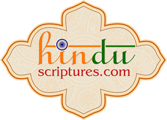FESTIVALS OF MANIPUR
Contents
- Introduction
- Various Festivals
Introduction
Manipur means the “land of jewels”. The State is nestled amidst hills, thick forests, clear blue lakes and an emerald green valley. Lord Irwin described Manipur as the “Switzerland of India”. Manipur boasts of a rich culture and an ancient tradition which is kept alive through the handloom woven clothes and handicrafts which are in great demand even to this day. Music and dance forms an integral part of the lives of the Manipuris. Some of the tribes who live in Manipur are: the Meiteis, the Kukis, the Anals, the Tangkhuls and the Monsangs. The Meiteis and the Tangkhuls are the most ethnic tribes living in the State. Maibas are the traditional priests of Manipur.
Various Festivals
Some of the festivals celebrated are as follows
Cheiraoba is the New Year of Manipuris celebrated on the first day of the month of Sajibu. (March- April).This is also known as the Spring Festival. The domestic deity, Sanamahi is worshipped. During the spring festival, people dress up in traditional attire, decorate their houses, prepare delicacies and offer it to the deity Sanamahi.
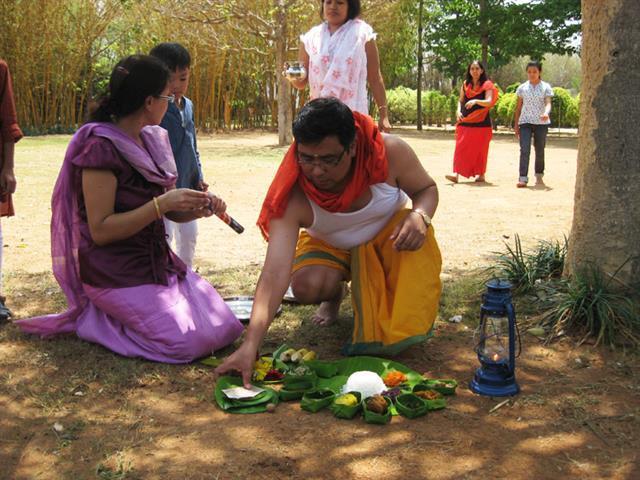
One of the important aspects of the festival is the selection of Chahitaba. Chahitaba is the man who is selected by the Maibas after comparing/scrutinising his horoscope. Chahitaba gives his name for the year and bears all the sins of the people and influences the good or ill of the whole community. An important ritual associated with the festival is that, people climb the Cheiraoching hill top, located in Imphal, with the belief that they can also scale great heights in life. The hill top houses a small Shiva temple. People living in other towns climb the nearby hill top. People also visit their relatives and exchange gifts and greetings for the New Year.

Yaoshang: is the main festival celebrated for five days commencing on the full moon day during February- March. During the festival, people perform a folk dance known as Thabal Chongba. Women go from door to door and collect donation for various religious activities. The fervour with which Yaoshang is celebrated is similar to Durga Pooja celebrated in West Bengal or Diwali in North India and Bihu in Assam.
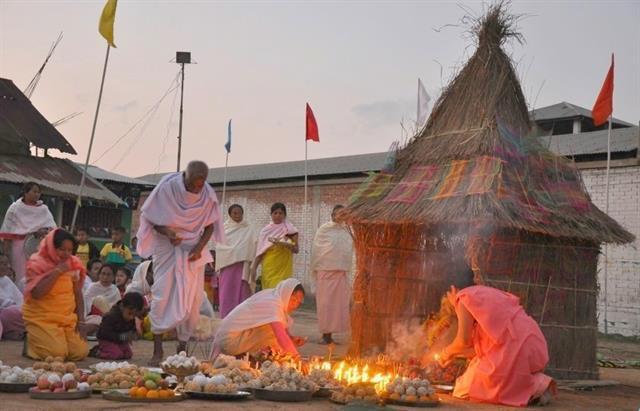
Kang Chingba festival: is a car (chariot) festival of Manipur celebrated for eight days in July. Meitei Hindus celebrate this festival. During the festival, the chariots of Lord Jagannath, His brother, Balarama and sister Subhadra are pulled by thousands of devotees. During the procession of the chariots of Lord Jagannath, Balarama and Subhadra, people offer flowers, fruits and sweets to the deities. People sing sankirtans during the procession. Men and women form separate circles and sing sankirtanas, which is followed by dance. After the song and dance, Prasad, known as Kshechiri is distributed to one and all. This festival is celebrated with the same fervour as the Jagannath Rath Yatra of Orissa. The festival is celebrated at Sri Govindajee temple, Imphal.

Heikru Hindongba: This festival, also known as the boat festival is observed on the eleventh day of the fortnight of Langbal month (September) of Meitei calendar. The festival is observed at Thangapat Shri Bijoy Govindajee, Sagolband, Imphal since ancient times. The festival is celebrated as a prayer for the well being of the people at large. The festival marks the boat race celebrated with great fervour. On the eve of the boat race, boats are cleaned and purified with the chanting of shlokas. The neck of the boat is decorated with garlands. Gold and silver coins are offered in a towel to the river before the boat race begins. Prayers are offered to the god of Meiteis- Sri Govindajee and the deity Rashewori before the start of the race. A grand garland made of 108 Heigrus with an alternate bud of Hup together with a garland of Cheng Machang (fine whole rice) made of 108 pieces is offered. The pandit or Maiba makes predictions for the year based on the outcome of the boat race. The winner of the race is garlanded with Heigru or Chengmachang. Boat race is a major rage among the youth in Imphal. Temporary tents are erected along the banks of the river where the boat race is conducted. The festival draws crowd from far and nearby cities and villages to witness the celebrations.
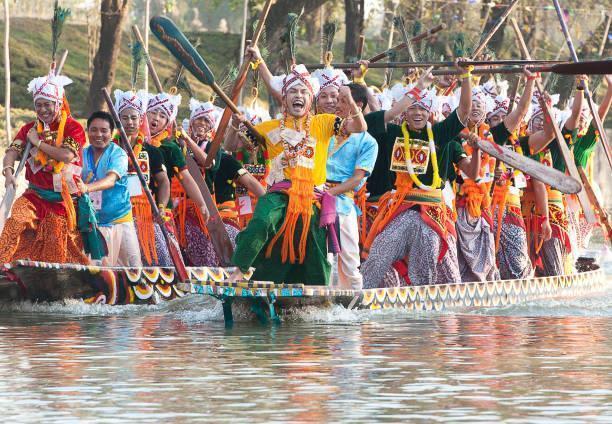
Laiharaoba Festival: is a festival celebrated by the Meiteis in May. Lai haraoba means “Festivities of the God”. During the festival, men and women worship the deity, Umang Lai. Some of the other major gods worshipped during the festival include, Sanamahi, Pakhangba, Nongpok Ningthou, Leimarel and Panthoibi. Apart from these gods and goddesses, about 364 Umang Lais and other forest deities are also worshipped by Meiteis. Dancing and singing in front of the images of the gods and goddesses is another ritual of the festival. In the evening, the deity, Umang Lei is taken in a procession in a palanquin in the locality. This is also the time when people pay respects to their ancestors and seek their blessings.
It is believed that the festival was first held in Koubru Ching, a hill situated in the northern end of Manipur. The festival has been celebrated since time immemorial to commemorate the creation of universe and various beings like plants animals and human beings. Traditional dance and songs form part of the celebrations.

Lui-ngai- ni: This is a festival observed by the Naga tribe on the 15th of February every year. Singing folklore and traditional dance mark the celebrations. This festival marks the beginning of the sowing season.

Gang Ngai: is a festival celebrated by the Kabui Naga tribes. This festival is observed in December- January for five days. The first day is the omen taking ceremony that is dedicated to the remembering of the ancestors. The remaining four days is spent in fun and frolic. Traditional cuisines, dance and song mark the celebration.
Ningol Chakouba: Ningol means married and Chakouba means invitation for a meal. The festival is a social occasion when married daughters are invited to their parental home for a feast. This is observed on the second day of the new moon of Hiyangei (November). The married daughters and sisters along with their children enjoy the grand feast with the entire family. The festival is observed by the Meiteis among the hill tribes and traditional songs and dance mark the festivities. Young and old people alike dress up in traditional attire including a headgear. On the occasion of the festival, gifts are exchanged between brothers and sisters.
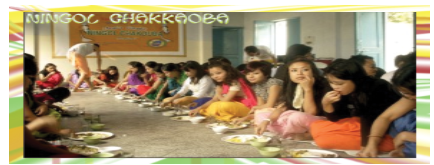
Kut Festival: Kuki Chin Mizo tribe of Manipur celebrate this festival on 1st November every year. The festival is known by different names such as Chavang Kut or Khodouat or Baisakh. The festival is celebrated as a thanksgiving to the Almighty for the bountiful harvest reaped in the year. A grand feast is organised when villagers get together and celebrate the festival. During the festival, people clean up and decorate their houses. The people celebrate the good harvest by singing traditional songs and dancing. Tourists who visit the State during autumn are treated with traditional cuisines and arts and crafts of the tribes.
Some of the other festivals of Manipur are Dol Jatra and Chumpha. Theatre or plays form an important part of the celebration of the festival in Manipur. The plays are based on ancient scriptures.
http://www.mapsofindia.com/manipur/society-and-culture/
http://manipur.nic.in/festi.htm
http://www.ask.com/wiki/Manipur
http://tourismmanipur.nic.in/festivals.html
http://www.indianholiday.com/fairs-and-festivals/manipur/laiharoba-festival-manipur.html
http://www.northeastindiatour.com/north-east-festivals.html
http://www.thegreenerpastures.com/north-east-india/festivals-of-north-east-india/festivals-of-tripura#.U-m9eD-Sw-M
